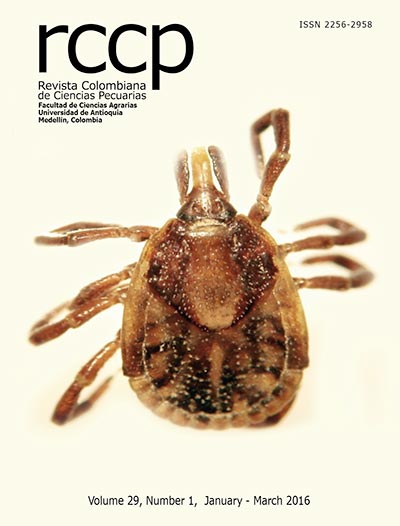Associação entre a avaliação genética e a aparência externa na pista de julgamento de bovinos de leite e de corte
DOI:
https://doi.org/10.17533/udea.rccp.324961Palavras-chave:
diferenças esperadas na progênie, habilidades de transmissão preditas, leilão, transformação rankitResumo
uma preocupação dos criadores é se a classificação dos animais baseada em avaliações genéticas é similar na pista de julgamento. Objetivo: determinar a associação entre a classificação de animais baseada no julgamento em pista e suas respectivas diferenças esperadas na progênie (EDPs) o habilidades de transmissão preditas (PTAs), para as animais Braunvieh (BR) e Brown Swiss (BS) do México. Métodos: os valores de classificação dos animais durante o julgamento foram transformados por meio da metodologia rankit. Para cada raça, análises de correlação de Pearson foram realizadas entre os valores de classificação transformados obtidos pela avaliação na pista de julgamento e seus valores de EPD o PTA. Resultados: usando a base de dados completa, em ambas as raças os coeficientes de correlação foram baixos (< 0,18) e diferentes de zero (p < 0,05). O coeficiente de correlação considerando as PTAs para produção de leite na BS foiligeiramente maior que os obtidos com qualquer EPD das características de crescimento na BR. Correlações em animais adultos (0,18 a 0,23) foram diferentes de zero (p < 0,05) e mais elevadas do que aquelas de animais jovens ou bezerros; enquanto que para as fêmeas e os machos foram semelhantes. Correlações por anos na pista de julgamento foram variáveis e sem tendência específica. Conclusões: a classificação de animais usando os resultados na pista de julgamento e as avaliações genéticas estão associadas, mas em baixa magnitude. A seleção de animais baseada nos resultados na pista de julgamento pode usar-se apenas como ferramenta complementar à avaliação genética.
Downloads
Referências
Beasley TM, Erickson S, Allison DB. Rank-based inverse normal transformations are increasingly used, but are they merited? Behav Genet 2009; 39:580-95.Boldman KG, Kriese LA, Van Vleck LD, Van Tasell CP, Kachman SD. A manual for use of MTDFREML. A set of programs to obtain estimates of variances and covariances [Draft]. USDA, ARS; 1995.Boligon AA, Mercadante MEZ, Albuquerque LG. Genetic associations of conformation, finishing precocity and muscling visual scores with mature weight in Nelore cattle. Livest Sci 2011; 135:238-43. Boostrom DR, Slanger WD, Moore BL. Heritability and repeatability of Hereford show-ring placing and associated correlations with individual performance measurements and expected progeny differences. J Anim Sci 1986; 63:1101-7.Chvosta J, Rucker RR, Watts MJ. Transaction costs and cattle marketing: the information content of seller-provided presale data at bull auctions. Amer J Agr Econ 2001; 83:286-301.Da Gama MPM, Araújo Neto FR, De Oliveira HN, Fernandes AR, Vercesi Filho AE, El Faro L, Paz CCP. Genetic parameters for rank of dairy Gir cattle in agricultural shows using Thurstonian procedures. Proceedings of the 10th World Congress on Genetics Applied to Livestock Production. Vancuover, BC, Canada, August 17-22, 2014.Estrada-León RJ, Magana JG, Segura-Correa JC. Genetic parameters for reproductive traits of Brown Swiss cows in the tropics of Mexico. J Anim Vet Adv 2008; 7:124-9.Simielli Filho EA, Mercadante MEZ, Silva JAV, Josahkian LA. Ranking of Nellore animals in cattle championships: genetic parameters and correlations with production traits. Genet Mol Res 2014; 13:5722-31.Guthrie LD, Majeskie JL. Dairy cattle judging teaches critical life skills. J Dairy Sci 1997; 80:1884-7.Madalena FE. Considerations on the management of animal genetic resources in Latin-America. EAAP/SLU/FAO/ICAR workshop on “Sustainable Management of Animal Genetic Resources: Linking Perspectives Globally”. Uppsala, Sweden, June 2, 2005.Madalena FE, Agyemang K, Cardellino RC, Jain GL. Genetic improvement in medium- to low-input systems of animal production. Experiences to date. Proceedings of the 7th World Congress on Genetics Applied to Livestock Production. Montpellier, France, August 19-23, 2002.Mc Hugh N, Evans RD, Fahey AG, Berry DP. Animal muscularity and size are genetically correlated with animal live-weight and price. Livest Sci 2012; 144:11-9.
Paneto JCC, Bittar ER, Barbosa EF, Rocha CD, Val JE, Ferraudo ES, Lôbo RD. Causes of variation in the prices of Nelore elite cattle in Brazil. Cienc Rural 2009; 39:215-20.Rocha CD, Barbosa EF, Ferraudo AS, Filho WK, Bittar ER, Oliveira PCL, Paneto JCC. Production and reproduction genetic trends of the Nellore beef cattle selected through visual assessment in Brazil. Proceedings of the 8th World Congress on Genetics Applied to Livestock Production. Belo Horizonte, Brazil, August 13-18, 2006.Saavedra Jiménez LA, Ramírez Valverde R, Núñez Domínguez R, García Muñiz JG, Lopez-Villalobos N, Ruiz-Flores A. Genotype by climate interaction in the genetic evaluation for growing traits of Braunvieh cattle in Mexico. Trop Anim Health Pro 2013; 45:1489-94.SAS. Statistical Analysis System User’s Guide (Release 9.2), SAS Institute Inc., Cary, North Carolina, USA; 2009.Schierenbeck S, König S, Simianer H. Genetic and environmental impact on auction prices for Holstein cows. Livest Sci 2009; 121:327-34. Vestal MK, Lusk JL, De Vuyst EA, Kropp JR. The value of genetic information to livestock buyers: a combined revealed stated preference approach. Agr Econ 2013; 44:337-47.
Downloads
Publicado
Como Citar
Edição
Seção
Licença
Copyright (c) 2016 Revista Colombiana de Ciencias Pecuarias

Este trabalho está licenciado sob uma licença Creative Commons Attribution-NonCommercial-ShareAlike 4.0 International License.
Os autores autorizam a RCCP a reimprimir o material nela publicado.
A revista permite que o(s) autor(es) detenham os direitos autorais sem restrições, e permitirá que o(s) autor(es) mantenham os direitos de publicação sem restrições.






